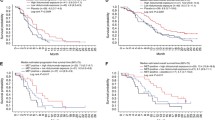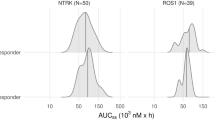Abstract
Purpose
To evaluate the exposure–overall survival (OS) relationship in patients with advanced pancreatic cancer treated with galunisertib plus gemcitabine (GG) or gemcitabine plus placebo (GP).
Methods
Galunisertib 300 mg/day was given orally as intermittent dosing and gemcitabine as per label. Galunisertib exposure metrics for each patient in the GG arm (n = 99) of a phase 2 study of pancreatic cancer were calculated. Parametric survival models were used to identify influential baseline and response covariates on OS.
Results
The population pharmacokinetics dataset included data from 297 patients/healthy subjects (age: 22–84 years, weight: 39–126 kg) across multiple studies, including this pancreatic cancer study. Galunisertib was rapidly absorbed with peak concentrations attained within 0.5–2 h and had an elimination half-life of 8 h. Between-subject variance on apparent clearance was estimated to be 47%. Age was the only characteristic to have a statistically significant effect on apparent clearance. A parametric Weibull survival model with treatment effect (dose) estimated a hazard ratio of 0.796, after adjusting for patient baseline factors that were significantly associated with OS. There was also a flat daily exposure–OS relationship within the observed exposure range, once all significant baseline covariates were included. Response covariates, such as reduction in CA19-9, time on treatment, and cumulative exposure over treatment cycles were also identified as significant factors for OS for patients with pancreatic cancer.
Conclusions
This analysis suggests that 300 mg/day galunisertib administered as 150 mg twice daily for 14 days on/14 days off treatment is an appropriate dosing regimen for patients with pancreatic cancer.





Similar content being viewed by others
References
Ahmed S, Bradshaw AD, Gera S, Dewan MZ, Xu R (2017) The TGF-beta/Smad4 signaling pathway in pancreatic carcinogenesis and its clinical significance. J Clin Med. https://doi.org/10.3390/jcm6010005
Smith AL, Robin TP, Ford HL (2012) Molecular pathways: targeting the TGF-beta pathway for cancer therapy. Clin Cancer Res 18:4514–4521. https://doi.org/10.1158/1078-0432.CCR-11-3224
Neuzillet C, Tijeras-Raballand A, Cohen R, Cros J, Faivre S, Raymond E, de Gramont A (2015) Targeting the TGFbeta pathway for cancer therapy. Pharmacol Ther 147:22–31. https://doi.org/10.1016/j.pharmthera.2014.11.001
Herbertz S, Sawyer JS, Stauber AJ, Gueorguieva I, Driscoll KE, Estrem ST, Cleverly AL, Desaiah D, Guba SC, Benhadji KA, Slapak CA, Lahn MM (2015) Clinical development of galunisertib (LY2157299 monohydrate), a small molecule inhibitor of transforming growth factor-beta signaling pathway. Drug Des Devel Ther 9:4479–4499. https://doi.org/10.2147/DDDT.S86621
Massagué J (2012) TGFbeta signalling in context. Nat Rev Mol Cell Biol 13:616–630. https://doi.org/10.1038/nrm3434
Bailey P, Chang DK, Nones K, Johns AL, Patch AM, Gingras MC, Miller DK, Christ AN, Bruxner TJ, Quinn MC, Nourse C, Murtaugh LC et al (2016) Genomic analyses identify molecular subtypes of pancreatic cancer. Nature 531:47–52. https://doi.org/10.1038/nature16965
Siegel RL, Miller KD, Jemal A (2016) Cancer statistics, 2016. CA Cancer J Clin 66:7–30. https://doi.org/10.3322/caac.21332
Miller KD, Siegel RL, Lin CC, Mariotto AB, Kramer JL, Rowland JH, Stein KD, Alteri R, Jemal A (2016) Cancer treatment and survivorship statistics, 2016. CA Cancer J Clin 66:271–289. https://doi.org/10.3322/caac.21349
Melisi D, Ishiyama S, Sclabas GM, Fleming JB, Xia Q, Tortora G, Abbruzzese JL, Chiao PJ (2008) LY2109761, a novel transforming growth factor beta receptor type I and type II dual inhibitor, as a therapeutic approach to suppressing pancreatic cancer metastasis. Mol Cancer Ther 7:829–840. https://doi.org/10.1158/1535-7163.MCT-07-0337
Dituri F, Mazzocca A, Fernando J, Peidrò FJ, Papappicco P, Fabregat I, De Santis F, Paradiso A, Sabbà C, Giannelli G (2013) Differential inhibition of the TGF-beta signaling pathway in HCC cells using the small molecule inhibitor LY2157299 and the D10 monoclonal antibody against TGF-beta receptor type II. PLoS One 8:e67109. https://doi.org/10.1371/journal.pone.0067109
Serova M, Tijeras-Raballand A, Dos Santos C, Albuquerque M, Paradis V, Neuzillet C, Benhadji KA, Raymond E, Faivre S, de Gramont A (2015) Effects of TGF-beta signalling inhibition with galunisertib (LY2157299) in hepatocellular carcinoma models and in ex vivo whole tumor tissue samples from patients. Oncotarget 6:21614–21627. https://doi.org/10.18632/oncotarget.4308
Ostapoff KT, Cenik BK, Wang M, Ye R, Xu X, Nugent D, Hagopian MM, Topalovski M, Rivera LB, Carroll KD, Brekken RA (2014) Neutralizing murine TGFbetaR2 promotes a differentiated tumor cell phenotype and inhibits pancreatic cancer metastasis. Cancer Res 74:4996–5007. https://doi.org/10.1158/0008-5472.CAN-13-1807
Stauber A, Credille K, Truex L, Ehlhardt W, Young J (2014) Nonclinical safety evaluation of a transforming growth factor β receptor I kinase inhibitor in Fischer 344 rats and beagle dogs. J Clin Pract. https://doi.org/10.4172/2161-0495.196
Gueorguieva I, Cleverly AL, Stauber A, Sada Pillay N, Rodon JA, Miles CP, Yingling JM, Lahn MM (2014) Defining a therapeutic window for the novel TGF-beta inhibitor LY2157299 monohydrate based on a pharmacokinetic/pharmacodynamic model. Br J Clin Pharmacol 77:796–807
Melisi D, Garcia-Carbonero R, Macarulla T, Pezet D, Deplanque G, Fuchs M, Trojan J, Oettle H, Kozloff M, Cleverly A, Smith C, Estrem ST et al (2018) Galunisertib plus gemcitabine vs. gemcitabine for first-line treatment of patients with unresectable pancreatic cancer. Br J Cancer 119:1208–1214. https://doi.org/10.1038/s41416-018-0246-z
Melisi D, Garcia-Carbonero R, Macarulla T, Pezet D, Deplanque G, Fuchs M, Trojan J, Kozloff M, Simionato F, Cleverly A, Smith C, Wang S et al (2019) TGFbeta receptor inhibitor galunisertib is linked to inflammation- and remodeling-related proteins in patients with pancreatic cancer. Cancer Chemother Pharmacol 83:975–991. https://doi.org/10.1007/s00280-019-03807-4
Doshi S, Gisleskog PO, Zhang Y, Zhu M, Oliner KS, Loh E, Perez Ruixo JJ (2015) Rilotumumab exposure–response relationship in patients with advanced or metastatic gastric cancer. Clin Cancer Res 21:2453–2461. https://doi.org/10.1158/1078-0432.CCR-14-1661
Zhao X, Suryawanshi S, Hruska M, Feng Y, Wang X, Shen J, McHenry B, Waxman IM, Achanta A, Bello A, Roy A, Agrawal S (2016) Assessment of nivolumab (Nivo) benefit-risk profile from a 240-mg flat dose versus a 3-mg/kg dosing regimen in patients (Pts) with solid tumors. Ann Oncol 28:2002–2008. https://doi.org/10.1093/annonc/mdx235
Food and Drug Administration (1999) FDA, Guidance for Industry: Pharmacokinetics http://www.fda.gov/downloads/Drugs/GuidanceComplianceRegulatoryInformation/Guidances/ucm072137.pdf. Accessed 19 Oct 2016
Lindbom L, Pihlgren P, Jonsson EN (2005) PsN-toolkit—a collection of computer intensive statistical methods for non-linear mixed effect modeling using NONMEM. Comput Methods Programs Biomed 79:241–257. https://doi.org/10.1016/j.cmpb.2005.04.005
Giannelli G, Villa E, Lahn M (2014) Transforming growth factor-beta as a therapeutic target in hepatocellular carcinoma. Cancer Res 74:1890–1894. https://doi.org/10.1158/0008-5472.CAN-14-0243
Poruk KE, Gay DZ, Brown K, Mulvihill JD, Boucher KM, Scaife CL, Firpo MA, Mulvihill SJ (2013) The clinical utility of CA 19-9 in pancreatic adenocarcinoma: diagnostic and prognostic updates. Curr Mol Med 13:340–351
Chiorean EG, Von Hoff DD, Reni M, Arena FP, Infante JR, Bathini VG, Wood TE, Mainwaring PN, Muldoon RT, Clingan PR, Kunzmann V, Ramanathan RK et al (2016) CA19-9 decrease at 8 weeks as a predictor of overall survival in a randomized phase III trial (MPACT) of weekly nab-paclitaxel plus gemcitabine versus gemcitabine alone in patients with metastatic pancreatic cancer. Ann Oncol 27:654–660. https://doi.org/10.1093/annonc/mdw006
Hammad N, Heilbrun LK, Philip PA, Shields AF, Zalupski MM, Venkatramanamoorthy R, El-Rayes BF (2010) CA19-9 as a predictor of tumor response and survival in patients with advanced pancreatic cancer treated with gemcitabine based chemotherapy. Asia Pac J Clin Oncol 6:98–105. https://doi.org/10.1111/j.1743-7563.2010.01290.x
Giannelli G, Santoro A, Kelley RK, Merle P, Gane E, Douillard J-Y, Waldschmidt D, Mulcahy M, Costentin C, Lorusso G, Gueorguieva A, Cleverly A et al (2013) Phase 2 study of the oral transforming growth factor-beta (TFG-ß) receptor I kinase inhibitor LY2157299. Paper presented at the International Liver Cancer Association, 13–15 September 2013; Washington DC, USA
Cervantes A, Elez E, Roda D, Ecsedy J, Macarulla T, Venkatakrishnan K, Roselló S, Andreu J, Jung J, Sanchis-Garcia JM, Piera A, Blasco I et al (2012) Phase I pharmacokinetic/pharmacodynamic study of MLN8237, an investigational, oral, selective aurora a kinase inhibitor, in patients with advanced solid tumors. Clin Cancer Res 18:4764–4774. https://doi.org/10.1158/1078-0432.CCR-12-0571
Steeghs N, Eskens FA, Gelderblom H, Verweij J, Nortier JW, Ouwerkerk J, van Noort C, Mariani M, Spinelli R, Carpinelli P, Laffranchi B, de Jonge MJ (2009) Phase I pharmacokinetic and pharmacodynamic study of the aurora kinase inhibitor danusertib in patients with advanced or metastatic solid tumors. J Clin Oncol 27:5094–5101. https://doi.org/10.1200/JCO.2008.21.6655
Zhu HP, Xia X, Yu CH, Adnan A, Liu SF, Du YK (2011) Application of Weibull model for survival of patients with gastric cancer. BMC Gastroenterol 11:1. https://doi.org/10.1186/1471-230X-11-1
Food and Drug Administration (2007) Guidance for Industry: Clinical Trial Endpoints for the Approval of Cancer Drugs and Biologics. https://www.fda.gov/downloads/drugsGuidanceComplianceRegulatoyInformation/Guidance/UCM071590.pdf. Accessed 21 Jan 2019
Acknowledgements
The authors would like to thank all investigators who participated in the study.
Funding
This study was sponsored by Eli Lilly and Company, manufacturer of galunisertib. Work in the unit of DM was supported by the Investigator Grant no.19111 through the Associazione Italiana per la Ricerca sul Cancro (AIRC). Medical writing assistance was provided by Samantha Forster, PhD, CMPP, of ProScribe—part of the Envision Pharma Group, and was funded by Eli Lilly and Company. ProScribe’s services complied with international guidelines for Good Publication Practice (GPP3).
Author information
Authors and Affiliations
Contributions
All authors participated in the interpretation of the study results, and in the drafting, critical revision, and approval of the final version of the manuscript. Ivelina Gueorguieva, Josep Tabernero, Michael M. Lahn, Ann Cleverly, and Karim A. Benhadji were involved in the study design. All authors were involved in data collection and interpretation. Josep Tabernero and Davide Melisi were investigators in the study. Ivelina Gueorguieva, Timothy H. Waterhouse, Colin Miles, and Ann Cleverly conducted the statistical analysis. The authors confirm that the principal investigators for this paper were Dr Josep Tabernero and Dr Davide Melisi, and that they had direct clinical responsibility for patients.
Corresponding author
Ethics declarations
Conflict of interest
Ivelina Gueorguieva, Ann Cleverly, Timothy H. Waterhouse, Colin Miles, and Karim A. Benhadji are current employees of and own shares in Eli Lilly and Company. Michael M. Lahn was an employee of Eli Lilly and Company during the design and conduct of the study and currently owns shares in Eli Lilly and Company. Josep Tabernero has had consultant/advisory roles for Amgen, Bayer, Boehringer Ingelheim, Celgene, Chugai, Eli Lilly and Company, Imclone, MSD, Merck Serono, Millennium, Novartis, Roche, Sanofi, Symphogen, and Taiho. Davide Melisi has received research funding from Celgene, Incyte, and Shire, and has a consulting role with Baxter, Eli Lilly and Company, Incyte, and Shire. Teresa Macarulla received honoraria for consultancy from Baxalta, Baxter, Celgene, Genzyme, Roche, Sanofi, Shire Pharmaceuticals, Tesaro, and QED Therapeutics, and has received travel/accommodation compensation from Bayer, H3 Biomedicine, Merck, and Sanofi. Valeria Merz has no conflicts of interest to disclose.
Role of the sponsor
Eli Lilly and Company was involved in the study design, data collection, data analysis, and preparation of the manuscript.
Ethical approval
All procedures performed in studies involving human participants were in accordance with the ethical standards of the institutional and/or national research committee and with the 1964 Helsinki Declaration and its later amendments or comparable ethical standards.
Additional information
Publisher's Note
Springer Nature remains neutral with regard to jurisdictional claims in published maps and institutional affiliations.
Electronic supplementary material
Below is the link to the electronic supplementary material.
Rights and permissions
About this article
Cite this article
Gueorguieva, I., Tabernero, J., Melisi, D. et al. Population pharmacokinetics and exposure–overall survival analysis of the transforming growth factor-β inhibitor galunisertib in patients with pancreatic cancer. Cancer Chemother Pharmacol 84, 1003–1015 (2019). https://doi.org/10.1007/s00280-019-03931-1
Received:
Accepted:
Published:
Issue Date:
DOI: https://doi.org/10.1007/s00280-019-03931-1




